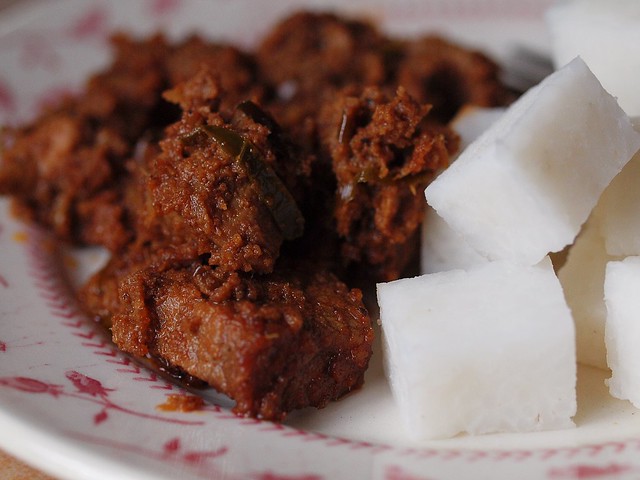.
For this year, I have decided to make beef rendang - after learning that my in-law is making chicken rendang. A quick rush after work Tuesday to get the essential ingredients ready, I worked on the cooking later in the evening.
For starters, rendang is one of the signature dish in the Malay cuisine. It's the festivities food. A must for big occasions. It is a very rich dish comprising mainly on the meat, coconuts (lots of them), seed spice, root spice and leaf spice. The preparation time is tedious as the amount of ingredients range from fresh to pre-processed sources. For the authentic rendang lover, all of the pre-processed ingredients are made fresh prior to cooking (which significantly extends the tediousness of preparing this magnificent dish).

E-30 with Zuiko Digital ED50mm F2.0
Beef Rendang with Rice Ketupat
I decided that 800g of meat, cut into bite-sized cutlets should be enough for the feasting of 6-8 adults. The coconut was freshly grated at the nearby shop, and I pressed about 600ml of it with a cup of warm water. After a few straining to separate the spent coconut flesh, the thick coconut milk (santan pekat) was ready.
Next came the root spice preparation. I used about 20 shallots to 5 garlic pieces, 6 inches of ginger (halia) with 5 inches of galangal (lengkuas) and 6 stalks of lemon grass (serai). All of these aromatics were pureed with a dash of warm water to make a paste.
Then, the seed spice was prepared. About a tablespoon of coriander seed (ketumbar), 50g dry chili (to boil) and a tablespoon of curry mix. All these were pureed with warm water to make a paste.
Finally, the leaf spice. I used 4 large size tumeric leaves (daun kunyit) and 10 kaffir lime leaves (daun limau purut). These were finely sliced into strips of roughly 2mm. The leaves were supposed to "dissolve" in the rendang.
Heat a half cup of oil in the wok, and sautee the root and seed spice. I continued stirring until the aroma started to permeate, and then I watched the heat so that the concoction wouldn't burn. I added 4 table spoons of brown sugar to sweeten the mix and let it caramelize. Then, I put in the coconut milk and beef, lowered the heat, and closed the wok. I let it simmer slowly for about an hour until the beef absorbed all the spicy goodness through the coconut milk.
Then, I put in a tablespoon of tamarind paste to counterbalance the sweetness. Finally, I added in the leaf spice and coconut paste (kerisik). Now, what makes a rendang a "true rendang" is the quality of the kerisik. What is so special about it? Well, it adds the extra dimension to the richness of the rendang. The kerisik is the soul of the rendang. It adds texture, taste and color to the rendang.
What is kerisik? Simply put, is toasted grated coconut pounded into paste. The finer the grate, the finer the texture and more even the toasting. The taste is richer, too. Once toasted, the coconut is pounded with a pestle and mortar until the texture is very fine and the oil starts to appear. The darker the toast, the more tart the kerisik will be. I am from the southern part of Malaysia, where prefer the kerisik to be a bit lighter. The northern part tends to have a more strong tasting kerisik; thus, darker rendang. To make kerisik from scratch takes about an hour from one coconut fruit.
Once I put the kerisik, the rendang was nearly ready. All it needed was the salt seasoning, and the final frying to make the gravy drier (the drier the rendang, the longer it will last without refrigeration). Then, I pair it with another traditional food; the ketupat (rice cake encased in coconut leaves). Personally, I prefer to have the ketupat with glutinous rice, which is much richer in taste as it is cooked and sauteed in coconut milk.
What can I say? This combination is full of good helpings of trans-fat and cholesterol. So, just watch the waist and blood pressure, and all should be fine. Just don't over-indulge, which is very difficult with such a succulent tasting dish!!!
Bon-a-petite....
No comments:
Post a Comment